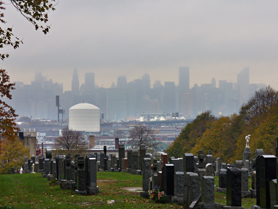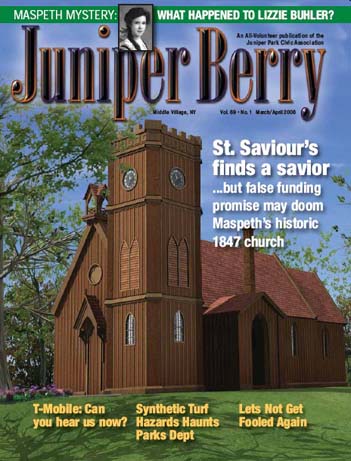In 1892, Maspeth was a sleepy farming town referred to as being “on the outskirts of the City of Brooklyn”. The untimely death of a popular young woman on a midsummer’s night unsettled many in the village and had them wondering whether or not her early demise was an accident or murder. For four days, the New York Times provided excellent coverage of the unfolding story. This is the second in a three part series.
MASPETH CALLS IT MURDER
________________________________________
STILL INVESTIGATING LIZZIE BUHLER’S DEATH
________________________________________
YOUNG EASER NOT TO BE FOUND – THE STORY CONTRACTOR FRANZ ABT HAS TO TELL – BURIAL OF THE VICTIM – WHAT JOHN LAUBY SAYS.
July 4th – The funeral of Lizzie Buhler, who was found dead by the railway track in Maspeth, L.I., on Saturday morning, within 300 feet of her home, took place there yesterday afternoon at 4 o’clock. All day long neighbors were bringing in flowers, until the little cottage seemed well nigh filled with them. For Lizzie was a favorite in the village, and all were anxious to show their affection for her and their sympathy with her family. The Rev. Mr. Ehler officiated at the services. Interment followed at Linden Hill.
During the day, the officers of the law were busy in taking evidence regarding the girl’s death. Constable George Hook of Newtown served the subpoenas and was at work all day. On almost the first trip he made he met with a surprise. He went to the home of Adam Easer on Metropolitan Avenue to get his son, Joseph Easer. He found that the young man was not at home, and had hardly been seen since the body of Lizzie was found. The family was unable to give any idea of his whereabouts.
The sudden absence of young Easer is generally regarded as curious. He had been paying the girl some attention.
When Coroner Brandon went to work on the case he learned that Lizzie was seen talking to a man on Flushing Avenue the evening of her death. He found this man to have been John Lauby, nineteen years old, who lives with his parents on Metropolitan Avenue, just beyond Schumacher’s Park. Accordingly, young Lauby was taken before the Coroner for examination yesterday morning. He said he met the girl with Richard Feldman at about 8:30 o’clock on Friday evening. She said to him: “I shan’t go to the milkmen’s picnic Monday; I’m going into the country.” This, he says, was all the conversation that passed. Then he left her, and went home and to bed. She went on with Feldman. He admitted having been intimate with the girl about a year ago, but not later.
Then Richard Feldman was summoned, and he told a somewhat similar story, except that he made it appear that Lizzie and Lauby were together when he met them. She had a bouquet, which he asked her for, and she gave it to him. Then he left, and Lauby also; and Lizzie walked on toward Schumacher’s Park. She carried a small bundle in her hand.
A Times reporter talked with Lauby yesterday, just after the examination of the boy by the Coroner. Lauby made to the reporter statements at total variance with those he made to the Coroner. He said that he saw the girl and she saw him, but that neither spoke or made any signs of recognition; also, that Feldman passed at the same time, but that he did not speak to either of them or they to him.
John Sayr, a young man of Maspeth, was also called as a witness. He said he used to “go with” Lizzie, and on one occasion last April he took her to the Lyceum Theatre in Brooklyn. He had had nothing to do with her since, because Joseph Easer was “going with” her, and objected to it. He added that about a year ago Joseph had told him of his acquaintance of Lizzie.
There is one witness whom the Coroner has not yet summoned, and who may throw some light on the matter. This is Franz Abt, who lives on the corner of Flushing Avenue and Garrison (now 54th) Street. He is a contractor and incidentally runs a beer saloon. To a Times reporter yesterday he told this story:
“I came home from my work on Friday night between 6 and 7 o’clock. I was tired and lay down for a little nap. I slept about three hours and went out on my back porch after I woke – some time between 10 and 11 o’clock.
“I heard voices from the sidewalk, not more than fifteen feet from where I stood. As I stepped out a woman was talking in a pleading way, as though asking someone to do something that the other person did not want to do. She said something like, “I want you to do what is right about it.”
“When they saw me come out they stopped talking, but still stood there. A man and a woman were there and the man had a horse. I looked pretty sharp, for I thought it was one of my horses. Then I saw it was not. I recognized the horse by a white mark on his forehead. He was facing me. The man was holding him by the bridle.”
“The girl was leaning with her back against the fence. I saw her plainly, and I knew her by her figure, her face and her voice. She was Lizzie Buhler.”
“Did you recognize the man?” was asked.
“I was sure of him, partly from his look and partly from the horse. I knew whose horse it was.”
“Who was he?”
“I don’t want to say anything more. I may get somebody into trouble.”
“Was he Joseph Easer?”
“No.”
“Was he John Lauby?”
Franz Abt threw out both hands and shivered.
“I don’t say anything more,” said he, but afterward he admitted that he recognized the horse as one belonging to Lauby’s father.
At the Lauby house, Mrs. Lauby, Miss Dora Lauby, and John Lauby himself united in telling the story of how John spent Friday night. He was at work paining a fence until nearly 8:30 o’clock. Then he put a bridle on the white-faced horse and rode down to Bender’s place on Flushing Avenue near Garrison Street (54th Street), to order some grain. He was not gone 10 minutes. When he came back, he went to bed almost at once. He sleeps on the ground floor and sleeps alone, and his mother had the usual trouble in arousing him the next morning.
So far all of the work of the Coroner has been along the line of a suspected murder. No attention has been paid to any other theory of the girl’s death. If it was an accident, it is held that her head must have been mashed, and there are no marks upon it save for two blows, believed to have been delivered before the cars struck her. The theory of suicide is scouted, on account of the manner of the car wounds and their position on the body.
The Coroner believes that the girl was struck on the head with a club or something like it and then, while either dead or unconscious, was placed upon the track.
It is thought that she had an appointment on Friday night to meet some person, for no inducement could persuade her to remain at home that night. She had gone to her father’s home to make that call, and had said she must go back that same night to the house where she was employed as a domestic at 1152 Lafayette Avenue, Brooklyn. She would not even allow her mother to walk with her to the place where she would take the car. She wanted to leave the house alone and go alone, and she did so. This was about 10:45 o’clock.
Her father’s house is close to the track of the Long Island Railroad, and within 300 feet of the place where her body was found the next morning. Yet no one in the neighborhood saw Lizzie pass along that short strip, and no one heard any unusual noise. It is not known where she went on leaving the house or whom she met. Her body was found the next morning at 5:30 o’clock by Adam Krummick.
Now, Adam Krummick lives beside the railroad track at the point where she was found. He did not go to bed until 11 o’clock, and that is pretty late for good Maspeth citizens to be up; so he is sure about the hour. He says there was no noise of disturbance up to that time.
The last train over the track that night passed that particular spot at 11:45 o’clock. The girl must have been run over by this train, and so must have been there before that hour. The fact that the neighborhood was undisturbed would indicate that she was not clubbed or killed at that place. The fact that the place is so short a distance from her home – not five minutes walk – would indicate that she did not proceed there on leaving home; and this is advanced as proof that her death was not due to accident.
The people in Maspeth are well-nigh a unit in support of the belief of the Coroner that a murder has been committed. The Coroner means to hold the inquest on Wednesday evening in the schoolhouse on Flushing Avenue, near Metropolitan Avenue. There has been a long list of death mysteries in that part of Long Island. It is on the outskirts of the City of Brooklyn and a criminal would have many chances of escape in his favor. The country is cut up with roads and railroads and offers a fine field for murder.
The plot thickens. The conclusion of this story will be printed in the next issue of the Juniper Berry. And we promise that it will surprise you.




